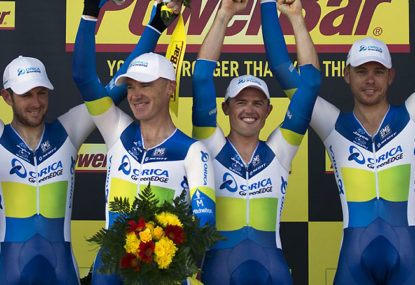'I've just won a stage of the Tour de France, mate!': Hindley grabs yellow jersey as Aussie blows Tour apart
Australia's Jai Hindley has said he is "lost for words" after a shock stage victory at the Tour de France earned him the leader's…

Last night the Australian Orica-GreenEDGEteam won the Team Time Trial and declared themselves as the strongest team in the 2013 Tour de France.
Although ‘strongest’ is a fairly circumstantial matter in cycling, I like to keep things simple, and to win an entirely teams-based event means you are the strongest team.
The funny thing was, everyone seemed so surprised.
The Italian commentators on RAI Sport were actually quite baffled that GreenEDGE featured on the results and many other television channels missed the elephant in the room too.
I am confused as to why, because even just looking at GreenEDGE on paper the pedigree was obvious, and my reasoning stems from our history on the track.
Let’s take a step back. Australia throughout recent history has been a global force on the velodrome.
I won’t bother listing palmares because they’re too numerous, but we have won nearly everything there is to win.
Today the world witnessed, in my opinion, the positive knock-on effects of a generation of Australian support for developing cyclists on the velodrome, before letting them free on the road.
I’ll give you a theoretical situation. Take a bunch of 16-year-old kids that have spent a few years already riding their bikes with their mates, training pretty hard, and have managed to win some state championships.
The riders then head off to the national championships, and achieve more fantastic results.
Top five in the country, that’s impressive; a ticket to the junior world track cycling champs.
In the next two months leading up to the big day, the boys (let’s use males in this instance, but this example isn’t entirely bias to one sex) are put into overdrive.
They assemble at a training camp – usually for the Australian juniors it’s Adelaide – and they start their preperation.
Training varies between twice a day track sessions and long road miles.
The track days consist of riding to and from the track – probably 20 or 30km in total – plus a set of efforts on either very big gear ratios or very small (relatively) gear ratios.
The hardest sessions see the majority spewing in the bins that run the oval periphery of the track.
Each session would generally contain one of the following: five 5km teams pursuits, five 1km teams pursuits, five 3km individual pursuits, 200 laps at upper zone two with a max sprint every 20 laps, or 10 standing start efforts in a huge gear.
Then they warm down and ride home to eat as much as possible before doing it all again in the afternoon.
The day’s end result being an utterly destroyed group of youngsters. Then there was the road training.
So we enter the amazing human body. Whether you call it overcompensation, shock therapy, or simply ‘torture,’ the lesson to be learnt is that if you push your body to its limits over and over again, it builds resilience.
Strength is gained, oxygen carrying capacity of the blood will increase, and toleration of pain will multiply.
This is the magic of repetition. Short, sharp, calculated repetition, at maximal exhaustion, with monitored recovery. The recipe for great things to happen.
Australia has had a history of brutally strong time trial riders, and to follow back through history it seems the majority started out on the track.
Today’s Orica-GreenEDGE team alone contained Cameron Meyer, Stuart O’Grady, Simon Clarke, Brett Lancaster and Matt Goss, who all have one track world title or another to their names.
In a close third place today was the British Team Sky, themselves too hosting a history of time trial-crushing world and Olympic track specialists.
It’s worth mentioning too that the training regime rumours about those fellas are just as brutal as anything going around.
Whether it be junior cycling sociability, or just an easy way of coaches and mentors to monitor the training of numerous young cyclists at once, an upbringing on the velodrome seems positive regardless.
Head down to your nearest track then, and look out for the elephant in the room.
One of the proudest moments of my career. Standing on the podium with my MATES,Yellow jersey,winning a stage in the TDF.I am so proud of OGE
— STUART O'GRADY (@StueyOG) July 2, 2013
I'm lost for words. Winning the ttt and taking yellow. It really doesn't get any better. #winnersaregrinners
— Simon Gerrans (@simongerrans) July 2, 2013
Fastest ever average speed in a TDF stage. 57.8kph!
— Matt Goss (@mattgoss1986) July 2, 2013
Follow Adam on Twitter @adamsemple